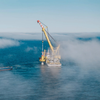U.S.: Stronger Response in South China Sea Needed
By releasing video of Beijing's island reclamation work and considering more assertive maritime actions, the United States is signaling a tougher stance over the South China Sea and trying to spur Asian partners to more action.
The release last week of the surveillance plane footage - showing dredgers and other ships busily turning remote outcrops into islands with runways and harbors - helps ensure the issue will dominate an Asian security forum starting on Friday attended by U.S. Defense Secretary Ash Carter as well as senior Chinese military officials.
As it pushes ahead with a military "pivot" to Asia partly aimed at countering China, Washington wants Southeast Asian nations to take a more united stance against China's rapid acceleration this year of construction on disputed reefs.
The meeting, the annual Shangri-La Dialogue in Singapore, will be overshadowed by the tensions in the South China Sea, where Beijing has added 1,500 acres to five outposts in the resource-rich Spratly islands since the start of this year.
"These countries need to own it (the issue)," one U.S. defense official said on condition of anonymity, adding that it was counterproductive for the United States to take the lead in challenging China over the issue.
More unified action by the partners, including the 10-member Association of Southeast Asian Nations (ASEAN), needed to happen soon because "if you wait four years, it's done," the official said.
While some ASEAN members, including U.S. ally the Philippines and fellow claimant Vietnam, have been vocal critics of Chinese maritime actions, the group as a whole has been divided on the issue and reluctant to intervene.
But in a sign of growing alarm, the group's leaders last month jointly expressed concern that reclamation activity had eroded trust and could undermine peace in the region.
Experts dismiss the idea of ASEAN-level joint action any time soon in the South China Sea. "It's absolute fantasy," said Ian Storey of Singapore's Institute on South East Asian Studies.
But stepped-up coordination between some states is possible. Japan's military is considering joining the United States in maritime air patrols over the sea. Japan and the Philippines are expected to start talks next week on a framework for the transfer of defense equipment and technology and to discuss a possible pact on the status of Japanese military personnel visiting the Philippines.
Carter, speaking in Honolulu en route to Singapore, repeated Washington's demand that the island-building stop, saying China was violating the principles of the region's "security architecture" and the consensus for "non-coercive approaches."
China claims 90 percent of the South China Sea, which is believed to be rich in oil and gas, with overlapping claims from Brunei, Malaysia, the Philippines, Vietnam and Taiwan.
SHOWING CHINA SOME "RESOLVE"
As part of Washington's drive to energize its allies, a U.S. Navy P-8 reconnaissance plane allowed CNN and Navy camera crews to film Chinese land reclamation activity in the Spratly islands last week and release the footage.
"No one wants to wake up one morning and discover that China has built numerous outposts and, even worse, equipped them with military systems," Assistant Secretary of State Daniel Russel said.
Ernest Bower, a Southeast Asia expert at the Center for Strategic and International Studies think tank in Washington, said the U.S. goal was to convince China to buy into the international system for dispute resolution rather than impose its sweeping territorial claims on the region.
But in the near term, he added: "I think the Americans are going to have to show China some resolve."
U.S. officials have said Navy ships may be sent within 12 miles (19 kms) of the Chinese-built islands to show that Washington does not recognize Beijing's insistence that it has territorial rights there.
Washington is also pressing ahead with its rebalancing towards Asia, four years after President Barack Obama announced the strategic shift, even as some countries say it is slow to take shape.
The United States has updated its security agreements with treaty allies Japan and the Philippines and is bolstering missile defenses in Japan with an eye on North Korea.
U.S. Marines are training in Australia on a rotational basis, littoral combat ships are operating out of Singapore and new P-8 reconnaissance planes stationed in Japan have flown missions across the region.
Overall, defense officials said, the Navy will increase its footprint by 18 percent between 2014 and 2020. The aim is to have 60 percent of Navy ships oriented toward the Pacific by 2020, compared to 57 percent currently.
Military officials in the Philippines say the U.S. shift has been noticeable, including military exercises, training and ship and aircraft visits. The emphasis has shifted from anti-terrorism to maritime security, one official said.
China has not shown any sign of being deterred. On Tuesday it held a groundbreaking ceremony for two lighthouses in the South China Sea, vowed to increase its "open seas protection," and criticized neighbors who take "provocative actions" on its reefs and islands.
By David Alexander









